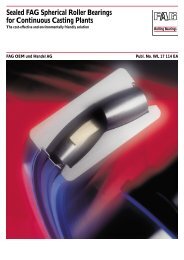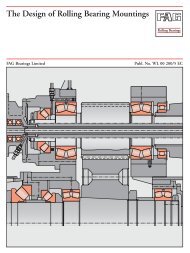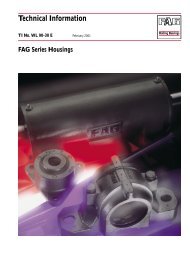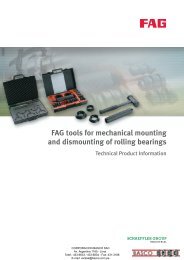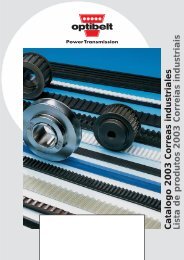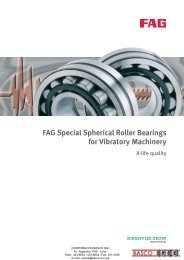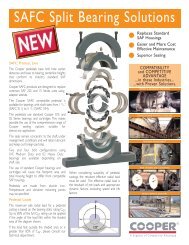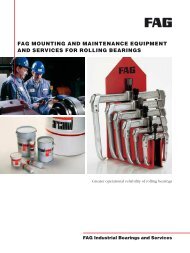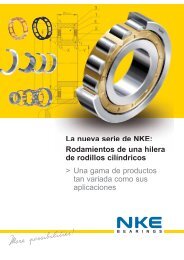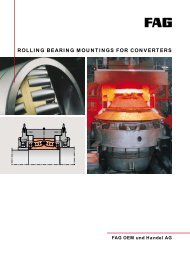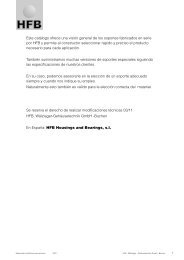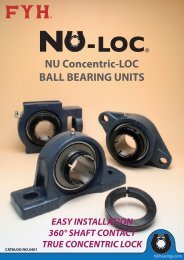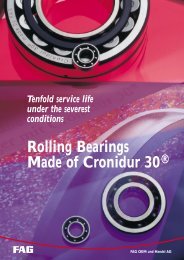75mm to 180mm SPLIT TAPERED BEARINGS
75mm to 180mm SPLIT TAPERED BEARINGS
75mm to 180mm SPLIT TAPERED BEARINGS
- No tags were found...
Create successful ePaper yourself
Turn your PDF publications into a flip-book with our unique Google optimized e-Paper software.
LubricationFittingsLubrication points are tapped 1/8”NPT and fitted with nipplesfor grease lubrication as standard. Grease nipples may beremoved and replaced with other fittings or pipes. Pipeworkmust be flexible <strong>to</strong> allow the swivel cartridge <strong>to</strong> functioncorrectly.BSP fittings may be used, but care must be taken <strong>to</strong> avoidblocking off the lubricant cross-drilling as these fittingsgenerally screw in further than NPT fittings.Lubricant typeCooper tapered bearings and housings are designed for greaselubrication. Grease is easier <strong>to</strong> retain in the housing thanoil, offering reduced lubricant loss and improved sealing. Italso offers better protection against corrosion <strong>to</strong> the rollingsurfaces.Greases of NLGI No.2 designation are recommended formost applications. For centrally pumped systems a No.1grease may be used for increased ‘pumpability’.Greases with extreme pressure (EP) additives arerecommended.11Grease with a lithium complex thickener is usually used fornormal applications operating at temperatures between0°C and 80°C. When water resistance is required a greasewith aluminium complex thickener can be used. Aluminiumcomplex greases are not compatible with some other typesof grease. The bearing must therefore be solvent cleaned ofother greases before adding an aluminium complex basedgrease.For extreme temperatures, speeds and loads always obtain alubricant recommendation from our technical department.Selection of base oil viscosityIn order for the bearing <strong>to</strong> have a long service life the greaseselected for bearing lubrication must have a base oil ofsufficiently high viscosity <strong>to</strong> adequately separate the rollingelements and race parts under operating conditions.The charts in Figure 2 show the recommended operatingranges for three common oil viscosities, for bearings undernormal loading (up <strong>to</strong> Cr/10).geometry fac<strong>to</strong>rShaft Diameterd (mm)BearingReferenceGeometryfac<strong>to</strong>r75 1DTB75M 6380 1DTB80M 6990 1DTB90M 78100 1DTB100M 96110 1DTB110M 110120 1DTB120M 118140 1DTB140M 144160 1DTB160M 169180 1DTB180M 196For example, if a 100mm bearing is <strong>to</strong> be run at 1200rpm:The geometry fac<strong>to</strong>r is 96 from the tableVelocity fac<strong>to</strong>r = 96 x (1200/1000) = 115.2To determine the suitability of one of these oils, draw avertical line from the horizontal axis at the calculated velocityfac<strong>to</strong>r, and draw a horizontal line from the vertical axis at theoperating temperature.If the lines intersect in the shaded area the viscosity of oil issuitable. If the lines intersect above the shaded area a higherviscosity oil is required. If the lines intersect below the shadedarea the bearing may operate satisfac<strong>to</strong>rily but it is suggestedthat a grease with a lower viscosity base oil is used.The use of these charts is subject <strong>to</strong> the operating conditionsbeing within the recommended ranges for the lubricant asspecified by the lubricant manufacturer.For conditions not covered by these charts please contact ourtechnical department.Note that the lubrication film thickness is not particularlysensitive <strong>to</strong> load, so for heavier loading the lubricant selectionas provided by these charts is usually sufficient providedthat the lines drawn on the chart as explained above do notintersect at the upper edge of the shaded area.To use these charts, find the ‘geometry fac<strong>to</strong>r’ for the bearingfrom the table below and multiply this by the bearing speed inthousands of rpm <strong>to</strong> obtain the velocity fac<strong>to</strong>r.



